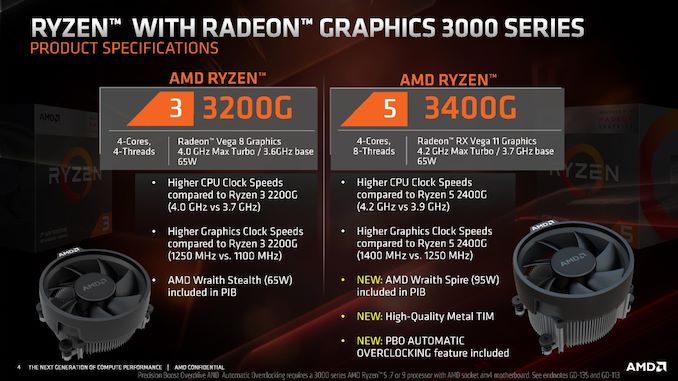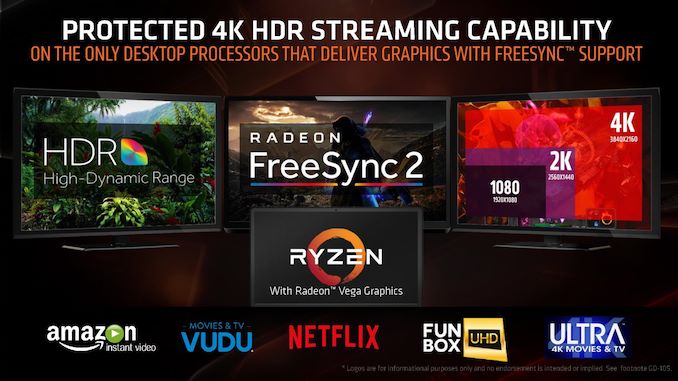AMD Ryzen 3000 APUs: Up to Vega 11, More MHz, Under $150, Coming July 7th
by Dr. Ian Cutress on June 10, 2019 7:40 PM EST
The integrated graphics ‘APU’ line of processors from AMD is a popular entry point for consumers on a budget based on the good performance from the cores, gaming-capable graphics, and all for a reasonable low cost that also comes bundled with a very sufficient cooler. AMD’s APU line is one lock-step behind its leading edge CPU technology, so this time around the new Ryzen 3000 APUs are built on last generation Zen+ 12nm technology, but with increased IPC, clock speeds, and an overall performance bump.
So truth be told, I’m a sucker for a good low cost entry-level processor. If you can provide me good performance and good gaming at a low price, then it becomes my go-to suggestion for low-cost builds to family and friends. These users might not need a discrete graphics card, but they need something to do desktop tasks with, and potentially game, without missing a beat. For the last generation, as seen from my CPU guides, AMD’s first generation Zen APUs filled that role. This will change come July 7th, as AMD will launch its Zen+ APUs to replace them.
| AMD Ryzen APUs | ||||||||
| AnandTech | Cores | Base Freq |
Turbo Freq |
IGP | IGP Freq |
DDR4 | TDP | Price |
| Ryzen 3000 'Zen+' | ||||||||
| Ryzen 5 3400G | 4C / 8T | 3.7 | 4.2 | Vega 11 | 1400 | 2933 | 65W | $149 |
| Ryzen 3 3200G | 4C / 4T | 3.6 | 4.0 | Vega 8 | 1250 | 2933 | 65W | $99 |
| Ryzen 2000 'Zen' | ||||||||
| Ryzen 5 2400G | 4C / 8T | 3.6 | 3.9 | Vega 11 | 1250 | 2933 | 65W | $159 |
| Ryzen 3 2200G | 4C / 4T | 3.5 | 3.7 | Vega 8 | 1100 | 2933 | 65W | $99 |
The Ryzen 5 3400G and Ryzen 3 3200G replace the 2400G and 2200G counterparts in the product line and offer two new speed jumps. The Zen+ architecture used in the new CPUs will offer a raw +3% throughput increase (IPC) in compute performance, as we saw when the main processor line moved from Zen to Zen+. The other factor is frequency – both new CPUs gain +300 MHz on the turbo frequency compared to the previous generation, as well as a +150 MHz increase in graphics frequency, all at the same power budget. The new APUs also support DDR4-2933, which will help with performance.
The other added bonus will be to the Ryzen 5 3400G, which will not only be released $10 lower than the 2400G, but it will now come with the 95W AMD Wraith Spire CPU cooler bundled in box, an upgrade over the 65W version previously used. This CPU will also be Indium-Tin soldered on for better thermal performance and potential in overclocking headroom.
A new feature coming to the APUs is support for 4K protected video streaming, such as Netflix 4K. This is a feature that has been missed on the previous generation, especially as AMD’s APUs have found their way into a number of small form factor systems and HTPC builds. The new APUs also support Radeon Anti-Lag, a new feature to reduce controller-to-display lag input times.
These CPUs are still PCIe 3.0, because they are one generation behind AMD's mainstream processors.
AMD’s messaging on these new APUs is that they will provide the best and most powerful integrated graphics on a desktop processor. With no competition in this segment, this is likely to be true. The processors are set to be launched on July 7th with the other members of the Ryzen 3000 family.
Related Reading
- ASRock Confirms Support for Ryzen 3000 APUs in DeskMini A300 SFF System
- Zen and Vega DDR4 Memory Scaling on AMD's APUs
- AMD Launches Ryzen Pro with Vega: Mobile APUs and Desktop APUs
- Delidding The AMD Ryzen 5 2400G APU: How To Guide and Results
- AMD Launches Ryzen 3 2200GE & Ryzen 5 2400GE 35 W APUs
- Overclocking The AMD Ryzen APUs: Guide and Results
- AMD Ryzen 5 2400G and Ryzen 3 2200G Integrated Graphics Frequency Scaling
- AMD Ryzen 5 2400G and Ryzen 3 2200G Core Frequency Scaling: An Analysis
- Marrying Vega and Zen: The AMD Ryzen 5 2400G Review













59 Comments
View All Comments
Cooe - Wednesday, June 12, 2019 - link
Yes, AMD has explicitly said "Zen+", and at this tech day they had direct access to the engineers, so if it wasn't Zen+, someone whould have corrected everyone.eastcoast_pete - Tuesday, June 11, 2019 - link
Thanks Ian! Like you, I have a soft spot (plus a self-serving interest, in the market for one) for these APUs. I have three questions: 1. Does media playback now support 10bit HDR (or better, HDR+)? 2. Does the build-in support for streaming 4K with HDCP 2.x avoid the need for the additional chiplet on the motherboard that one needs with Intel's 8th/9th gen CPUs? And, 3., any changes in the L2 and L3 cache sizes compared to the 2400G?I wonder how much the smallish cache of the 2200G/2400G APUs holds not just the CPU, but especially the iGPU back. AFAIK, CPU and GPU share the L3 cache in these APUs, and those 11 VEGA units are likely to run into memory speed limits if the amount of (shared) cache they can use is as small as it was for the 2400G.
Santoval - Tuesday, June 11, 2019 - link
Regarding #3, due to the switch to Zen+ the cache sizes are identical, however the latency of all three caches was markedly improved. This is where the extra IPC is derived from.eastcoast_pete - Tuesday, June 11, 2019 - link
Also, bravo AMD for (finally) using metal TIM at least for the 3400G, and (for the same chip) now including the much better wraith spire heatsink! Both are noteworthy changes!Oxford Guy - Friday, June 14, 2019 - link
Too bad the underlying chip is boring.Until DDR4 isn't such a bottleneck, for example...
Dragonstongue - Wednesday, June 12, 2019 - link
maybe AMD was "nice enough" this go around and will allow their APU to get a full "width" pci-e link for GP use instead of the slight bottleneck via last go around A and B hopefully this time around there is none of this $99 chip often enough actually being faster and better game performance as it's core was not pushed to the very edge of what it can reasonably do via it's TDP limits (total power for everything has to be split on the fly cannot be an easy thing.Einy0 - Wednesday, June 12, 2019 - link
I still can't believe how they soiled this website with these auto-play videos! Anand must be heart broken at how quickly Purch destroyed what he worked so hard and so long to build.Qasar - Thursday, June 13, 2019 - link
sadly.. that is why i use an adblocker now... the ads are just so bad, it takes A LOT longer to load any page on here.infaz - Sunday, May 3, 2020 - link
Is Ryzen 5 3400g supporting netflix 4k HDR? or else do you need to have a Radeon card for that?